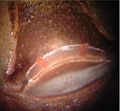Grammostola rosea
| Grammostola rosea | ||||||||||||
|---|---|---|---|---|---|---|---|---|---|---|---|---|

Grammostola rosea , female |
||||||||||||
| Systematics | ||||||||||||
|
||||||||||||
| Scientific name | ||||||||||||
| Grammostola rosea | ||||||||||||
| ( Walckenaer , 1837) |
Grammostola rosea (sometimes also called "Red Chile tarantula" in German) is a species of tarantula from Chile , which is also found in Argentina , Bolivia and Paraguay .
It used to be known under the names Grammostola cala and G. spatulata and is sometimes still marketed under these names today. In the pet trade, G. cala was the name given to the reddish color of this species and G. spatulata to the brownish color . In South America it is called the "pink tarantula" (tarántula rosa).
Appearance and build
The animals reach a body length of 5 to 7 cm. The color can vary from bright red to dark brown. The head and chest piece, the prosoma , or - less precisely - the cephalothorax , is protected by a chitinous back shield, the carapace , which is bright reddish in color, especially in adult males. The entire hair is short. Two lines are clearly visible on the legs of darker specimens. The legs of the young are pale pink in color. The abdomen is dark brown. With each moult, the legs get darker. There are stinging hairs on the opisthosoma (abdomen, abdomen ) . They are renewed with each moult .
Sperm library , greatly enlarged
Way of life
Grammostola rosea lives in self-made residential tubes in the humid regions of Bolivia , Argentina and Chile . These living tubes, which are up to one meter deep, are mainly created in wet, loose soil and serve as a retreat for the spiders. The regions inhabited by this species are sometimes subject to large seasonal fluctuations. The animals compensate for this by hibernating for a few months.
Grammostola rosea , like all tarantulas, is a stalker . It feeds mainly on insects such as B. cockroaches, more rarely from small mammals.
Species protection
Although it is not known whether Grammostola rosea is threatened locally, the mass imports for the European pet trade are certainly to be viewed critically, especially since this species can be reared without any problems and is also in Germany.
literature
- »ARACHNE« - the specialist magazine for arachnids ( ISSN 1613-2688 )
- B. Striffler (2004): The red Chile tarantula (Grammostola rosea) + other Grammostola species. Natur und Tier Verlag, Münster. ISBN 3-937285-41-5
Web links
Grammostola rosea in the World Spider Catalog
Individual evidence
- ↑ Grammostola rosea / Vogelspinne vogelspinnen-info.de , accessed on December 28, 2018.
- ^ A b Günther Stadler: Vogelspinnen , bede-Verlag, pp. 70–71. ISBN 3-933646-15-4




